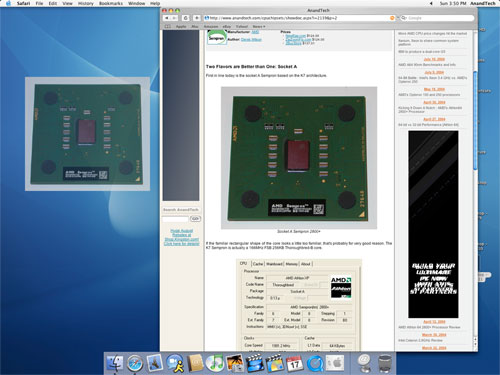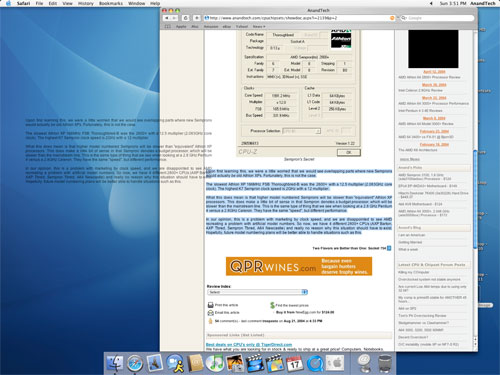A Month with a Mac: A Die-Hard PC User's Perspective
by Anand Lal Shimpi on October 8, 2004 12:05 AM EST- Posted in
- Mac
What you want is what you get
It's tough to find a section to write about in this next set of OS X features because in what section do you talk about the cool things that I've always wanted to do in Windows, but couldn't because they weren't supported? What sort of cool things, you ask?Under OS X, the term drag-and-drop is really taken to a new level - you can drag and drop just about anything. Let's say, you really like one of the pictures in this review. Under OS X, you could simply click and drag the image to your desktop or any folder and a copy of it would be saved. The dragged image appears as a smaller, slightly translucent version of the original, which obviously remains untouched. For whatever reason, this process is quite CPU intensive, making the G5's fans spin up if you drag an image for too long. With two CPUs, however, it's not really invasive, but it's just interesting to hear fans spin up while you're dragging an image around. The benefit of this stretches far beyond just saving an image. You can drag it into an IM window to send someone a URL of the image, or you can drag it into an email to send someone a copy of it. I'm a huge fan of car discussion boards online and I'm always sending pictures of up and coming cars that I may come across online to friends. The drag-and-drop of an image into an IM window makes the process a lot easier than right-clicking on an image, going to its properties and copying the URL, and then pasting it into an IM window.
If you're writing an email and don't want the window to shift focus to your web browser with the image in it, just hold down the Command key; you can still drag the image without shifting the window focus. The same thing can be done with text, whether it is a single word or an entire paragraph of text - just highlight and drag it to wherever you want it.
Going along with the "everything is draggable" motif, there is also an easy way of dragging a file other than an image without resorting to dragging its actual icon. In the titlebar of most windows where you're creating or editing content, there's a little icon that can be dragged from the titlebar to just about anywhere; in the case of an Office document, dragging that icon will copy the file to any location or attach it to an email. The feature is also pretty smart; you can't drag the icon unless the document that you're trying to copy/attach has been saved since your last changes.
![]()
Want to open a lot of files using a particular program (not necessarily the one that they open with by default)? Just drag them to the program's icon on the dock. There are tons of little features like these that I ended up appreciating quite a bit. I know that it's not hard to open up a few folders to copy a file, but this way is just quicker and just so much more intuitive. If you're looking at something, why shouldn't you be able to drag/copy/attach the file without having to find it in another form somewhere else? It seems to me that Apple asked that very same question.
The final cool feature that I'd like to mention briefly here is OS X's system-wide spell check. Any window, whether it is a text document, IM, email, form in a browser or anything else where you're inputting text, OS X checks spelling for you. It can be disabled in specific applications if you'd rather not be bothered, but it is very useful.












215 Comments
View All Comments
webchimp - Friday, October 8, 2004 - link
When you compared multitasking performance on a Mac to a Windows PC, was the Windows PC also a dual processor machine?One of the major benefits of multiple processors is multitasking performance and it would be unfair to compare a single processor PC to a multi processor PC regardless of the particular CPU and OS.
insomn - Friday, October 8, 2004 - link
"When writing an article (especially big NDA launches), I'd have around 20 IE windows open"IE?
www.getfirefox.com
20 IE windows = 1 firefox window.
CindyRodriguez - Friday, October 8, 2004 - link
I'll try to only comment on the big stuff.Anand doesn't get the application install process at all. He's overthinking it way too much. Things don't have to be 'windows complicated' in OS X.
In a drag and drop install, you aren't copying the "Application Installer" over to the hard drive. You're actually copying the Application its self over.
Applications in OS X are actually bundles. They appear as binaries but they are actually directories with a hidden .app suffix on them. Select any OS X native App and control-click or rightclick on it. A contextual menu will pop up, select "Show Package Contents". This is the whole application.
Contrary to what Mr. Shimpi said, there is no process were files are auto-magically copied to hidden and forbiden regions of your hard drive when you copy an application bundle from the installer disk to your hard drive. The application is entirely selfcontained so you are actually dragging everything over in one fell swoop. There is no disconnect because what you see in the install is what you get, a simple copy. OS X bundles are actually incredibly elegant ways to package applications.
Some applications do require some additional files to be installed into the OS and this is where Anand was getting confused. Not all application installs in OS X are simple drag-drops. Many use more familiar installer shells. Some Drag and Drop installs also contain self repairing, Office is one example. Though the install is simply a copy, the application does require some files (like fonts for example) to be installed into the OS. This occurs when the application is first run, not when you copy the application over. On subsequent launches, if any of the required support files have been removed, they are reinstalled in much the same way. This is also a very nice feature.
Chuckles - Friday, October 8, 2004 - link
With regard to your trouble opening folders and applications using the keyboard:Command-o opens whatever you have highlighted. I had never heard of Command-Shift-Down Arrow opening stuff before this.
CindyRodriguez - Friday, October 8, 2004 - link
Argh.. I could only get through the first two pages before I was ready to pull my hair out.* The article is outdated even though it was published today. Apple rev'ed that machine in July.
* G5s are expensive but so are similarly configured PCs. A dual opteron or dual Xeon from a real vendor with a real warranty will cost you just as much or more than the G5. I've actually spec'ed out dual G5s next to dual Xeons and dual Opterons and contrary to what Mr. Shimpi says.. do don't get "much more". Do it your self everyone.. but remember that a dual 2GHz isn't a $3K computer anymore.
* Your overview of the Mac on page 2 is wrong. Apple didn't ship a Radeon 9600. The rev one shipped with a Radeon 9600Pro. That may seem like picking nits.. but I bet you'd consider is significant if I offered you a free 9600Pro or a free 9600 but not both.
* Anand tells us in Page 2 to look at the specs to see how mediocre they are.. but he forgets to remind us that this computer is a Rev 1, not a rev 2.
* Anand apparently didn't bother to look at Apple's new DVI monitors. He asserts that you loose the cable clutter cutting benefits of ADC but this isn't true. There is STILL only one cable to the DVI monitor. The cable breaks out to power/usb/dvi at the computer end.. in fact, Apple's new cable now includes firewire.
* Once again, to pick nits.. the mouse cable on an apple mouse is short to plug into the keyboard not the monitor. Apple keyboards have always had pass through ports for the mouse.
I'll try to trudge through the rest when I get time.. but it's pretty painful so far.
knutp - Friday, October 8, 2004 - link
Sure there is a 2004 version of the Office pacage. Remember that this is a version only suited for Mac OS.http://store.apple.com/1-800-MY-APPLE/WebObjects/A...
KutterMax - Friday, October 8, 2004 - link
One aspect not touched on in the review is some of the other applications included with the G5, that being iMovie, iPhoto, and iDVD.I'm a PC user but my wife has her own G5. She does a lot of work with digital photography and video and uses these apps a ton. They seem to work really well and integrate nicely together. $3000 is a lot to justify for a machine, but certainly these apps add some value. Further, an iMac G5, which would be about half the price, would also include these same apps and provides a little more value for the money (but only a single processor).
ksherman - Friday, October 8, 2004 - link
the current version of the MS Office is 2003, not 2004... But a very god article indeed... Though i dont think ill be slapping down $3000 down for anything except a down payment on a car! :) I do agree that the slow downs that exist are crazy, given such an expensive computer. The fact that over 1GB memory is practically REQUIRED is a bit of an annoyance. But thats the price for a sexy OS!sgd2z - Friday, October 8, 2004 - link
ThatGuyPSU - Friday, October 8, 2004 - link
Thanks, Provia. I realized that after I hit Post Comment. Regardless, MS Office 2004 for the PC doesn't exist and probably won't since we're just about at the end of 2004. If anything, you'll see an MS Office 2005.